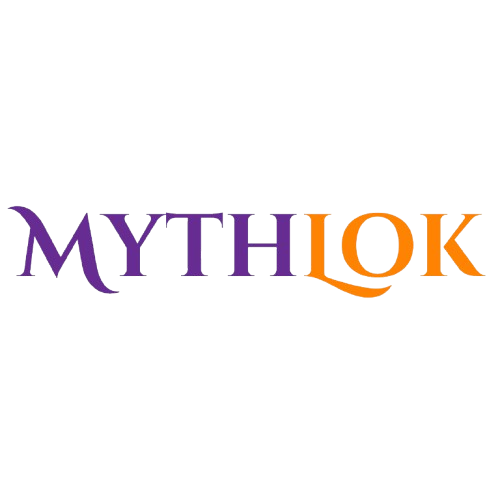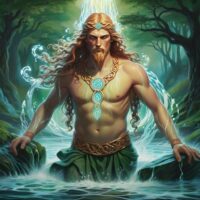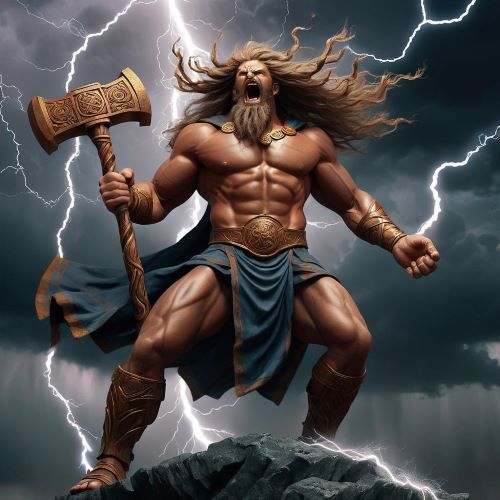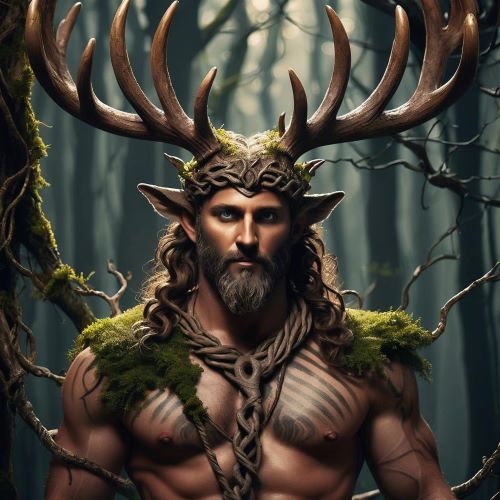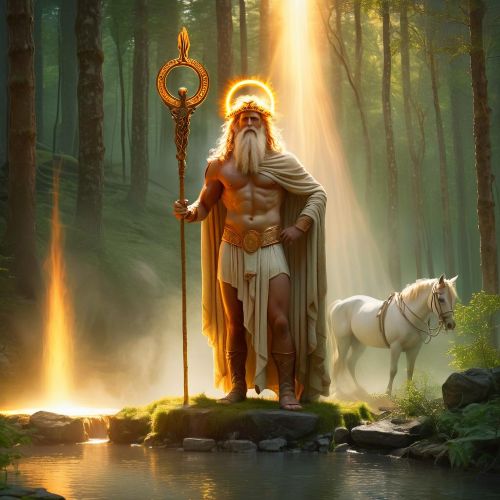Alaunus : God of Prophecy
Listen
At a glance
| Description | |
|---|---|
| Origin | Gaulish Mythology |
| Classification | Gods |
| Family Members | N/A |
| Region | France, Belgium, Luxembourg, Switzerland and Northern Italy |
| Associated With | Healing, Prophesy, Water |
Alaunus
Introduction
Alaunus is a lesser-known but captivating figure from Gaulish mythology, revered as a god of healing and prophecy. Though historical records are sparse, his presence is marked by a few significant inscriptions discovered in places like Southern France and Western Germany. These remnants hint at a once-vibrant spiritual role, particularly in the realms of health and divination.
What makes Alaunus especially fascinating is his connection to natural forces—particularly water, which was often linked to healing in ancient Celtic belief systems. Springs and rivers were seen not just as physical lifelines but as conduits of mystical energy, and Alaunus was closely tied to these sacred flows. His name even lives on in several European place names and river names, rooted in the feminine form Alauna, derived from the proto-form *Alamnā.
There are signs that Alaunus may have been merged with Roman deities over time, most notably Mercury, suggesting a blending of traditions as Roman influence spread across Celtic territories. This syncretism illustrates how flexible and adaptive ancient spiritual practices could be, with gods evolving to meet the changing needs and influences of their worshippers.
Physical Traits
Unlike more prominent deities whose images were immortalized in statues or detailed artworks, Alaunus exists in a more elusive visual form. Most impressions of his appearance are pieced together from fragmented archaeological finds—votive offerings, inscribed stones, and recurring symbols rather than direct depictions. These suggest he was imagined as a youthful, vibrant figure closely tied to the natural world, especially water, which symbolized healing and renewal in Celtic belief.
While no universally accepted image of Alaunus survives, certain artistic cues hint at his spiritual role. Motifs like flowing lines, spirals, and water imagery—common in Gaulish design—point to a deep connection with rivers and springs. Some interpretations even suggest he may have been envisioned with water-themed adornments, possibly a halo or crown symbolizing the life-giving energy of freshwater sources. His clothing, inferred from the artistic language of the time, likely featured earth-inspired patterns, blending human form with nature’s symbols.
There’s also speculation that Roman influence, particularly through the god Mercury, may have shaped how Alaunus was imagined. Since Mercury was typically depicted as athletic and youthful, Alaunus may have shared a similarly energetic, approachable presence. Though we can’t say for certain what he looked like, the way his imagery intertwines with natural motifs and Roman parallels paints a picture of a god who was both grounded in the elements and elevated by divine wisdom.
Family
Very little is known about Alaunus’s divine lineage, which is not unusual in Gaulish mythology, where clear-cut genealogies were rarely emphasized. Unlike mythologies that offer detailed family trees for their gods, the Celtic worldview often favored fluid relationships and overlapping roles among deities. In Alaunus’s case, the records leave much to interpretation.
Some inscriptions and comparative myth studies suggest he may have shared symbolic or functional ties with other nature-focused gods. He is occasionally associated with Helios-Apollo from Greek tradition and with Mercurius in Roman syncretism, hinting at a shared space within a broader pantheon of healer-deities and celestial intermediaries. These connections were likely more thematic than familial, reflecting similar domains of influence rather than bloodlines.
In some regional traditions, Alaunus may have existed as part of a divine grouping—possibly a duo or triad—representing interconnected forces like health, fertility, and the flow of life through water and earth. Such groupings were common in Celtic spirituality, where gods and goddesses worked in harmony rather than hierarchy. Though no direct mythological family is attributed to him, Alaunus’s role as a healer and prophet places him firmly among the revered spirits who maintained balance between humanity and the natural world.
Other names
Because Gaulish religious practices were deeply local and passed down through oral tradition, it’s no surprise that many deities—including Alaunus—appear under multiple names depending on the region and historical context. Inscriptions have recorded variations like “Alaunos” and “Alainos,” reflecting shifts in pronunciation, regional dialects, and the blending of cultural influences over time. These differences don’t point to entirely separate figures, but rather to the evolving nature of how communities understood and honored their gods.
Modern scholars and enthusiasts occasionally link Alaunus with similarly named figures in Breton and Celtic traditions, illustrating how mythological identities can blur across centuries. Such overlaps are a common feature in Celtic lore, where names are not fixed labels but carriers of meaning, shaped by language, culture, and spiritual interpretation.
The origin of the name itself remains a subject of debate. Some linguists trace it to the Proto-Celtic root *al-, suggesting a meaning related to nourishment or care—perhaps casting Alaunus as a life-sustaining force. Others, like Xavier Delamarre, offer a different angle, interpreting the root as meaning “to wander,” which resonates with his associations to rivers, journeys, and the ever-flowing nature of water. These varying interpretations enrich our understanding of Alaunus, offering glimpses into how ancient peoples may have seen him—not just as a deity, but as a symbol of movement, vitality, and spiritual sustenance.
Powers and Abilities
Alaunus held a vital place in the spiritual life of the ancient Gauls, primarily revered for his abilities to heal and to offer prophetic insight. Far more than just a curer of physical illness, he embodied a holistic approach to well-being, attending to the emotional and spiritual wounds of his followers as well. His presence was often sought during times of personal hardship or communal distress, when guidance and renewal were most needed.
His deep connection to water—especially springs and flowing rivers—was no coincidence. In many ancient cultures, and particularly among the Celts, water symbolized purification and transformation. Sacred rites in his honor frequently involved water as a medium for spiritual cleansing and rebirth, emphasizing his role as a force of rejuvenation. Whether through ritual bathing, offerings at sacred wells, or quiet meditation beside a stream, worshippers engaged with Alaunus as a divine conduit for the return of health and vitality.
Beyond his healing nature, Alaunus was also turned to for his gift of foresight. In a world deeply attuned to omens and natural signs, he was believed to possess the wisdom to glimpse what lay ahead. This ability made him an essential guide not only in personal matters, but also in decisions that affected entire communities—such as planting cycles, migrations, or leadership choices. His foresight was seen as a gift that helped align human action with the rhythms of the earth.
The blend of healing and prophecy in Alaunus’s character reflects a worldview where health and clarity were interconnected, and where spiritual balance was achieved through harmony with nature. His legacy lives on in the symbolic understanding of water, cycles, and the timeless human desire to heal and know what comes next.
Modern Day Influence
Although not as widely recognized as other figures from Celtic mythology, Alaunus continues to capture attention in modern explorations of ancient belief systems. His quiet yet persistent presence in academic studies and spiritual communities reflects a growing desire to reconnect with forgotten or lesser-known deities. Alaunus, with his ties to healing and foresight, appeals to those looking beyond mainstream mythologies for insight and meaning.
In recent decades, there has been a notable revival of interest in pre-Christian traditions, and Alaunus has found a place within this broader cultural movement. Contemporary neo-pagan groups and enthusiasts of Celtic heritage frequently honor him in seasonal rites or personal practices focused on wellness and inner clarity. His symbolism—especially his link to sacred waters—has inspired modern rituals that emphasize emotional healing, intuitive wisdom, and the cyclical nature of life.
Beyond spiritual circles, Alaunus also resonates within artistic and ecological spheres. Writers and visual artists have reimagined him as a figure of calm strength, drawing on his lore to explore themes of restoration, flow, and insight. In environmental discourse, he occasionally emerges as a symbolic guardian of fresh water and ecosystems—a timeless reminder of humanity’s responsibility to live in harmony with the earth.
Whether evoked in meditation, celebrated in folklore festivals, or referenced in creative expression, Alaunus’s legacy continues to evolve. His ancient essence has adapted to contemporary concerns, offering a connection between the old world and the new—one that speaks to the enduring power of healing, vision, and respect for the natural world.
Related Images
Source
Celtic Mythology Official. (2025). The Pantheon of Gaulish Gods. Retrieved April 2025, from https://www.celticmythology.org/gods/alaunus.
Alauna – Wikipedia. (2005, September 12).
Alaunus – Hearthfire Handworks. (2017, July 21).
Celtic Gods | Labyrinth Comics Database Wiki – Fandom.
Celtic Mythology Submitted Names – Behind the Name.
Gods and Goddesses of health – Damir na divanu. (2020, January 12).
Ancient Celtic History. (2025). Ancient History and the Gauls: Overview. Retrieved April 2025, from https://www.ancient-celtic-history.com/gaulish-deities.
Frequently Asked Questions
What is lorem Ipsum?
I am text block. Click edit button to change this text. Lorem ipsum dolor sit amet, consectetur adipiscing elit. Ut elit tellus, luctus nec ullamcorper mattis, pulvinar dapibus leo.
What is lorem Ipsum?
I am text block. Click edit button to change this text. Lorem ipsum dolor sit amet, consectetur adipiscing elit. Ut elit tellus, luctus nec ullamcorper mattis, pulvinar dapibus leo.
What is lorem Ipsum?
I am text block. Click edit button to change this text. Lorem ipsum dolor sit amet, consectetur adipiscing elit. Ut elit tellus, luctus nec ullamcorper mattis, pulvinar dapibus leo.
What is lorem Ipsum?
I am text block. Click edit button to change this text. Lorem ipsum dolor sit amet, consectetur adipiscing elit. Ut elit tellus, luctus nec ullamcorper mattis, pulvinar dapibus leo.
What is lorem Ipsum?
I am text block. Click edit button to change this text. Lorem ipsum dolor sit amet, consectetur adipiscing elit. Ut elit tellus, luctus nec ullamcorper mattis, pulvinar dapibus leo.

